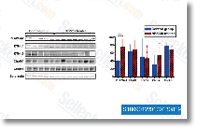The multi variate examination utilized exactly the same reference groups as the univariate analyses against which another groups haz ard ratios had been examined. Much like the univariate evaluation, the Asian Pacific Islander as well as other racial groups haz ard ratios have been considerably better compared to the reference group of White patients, Likewise, we identified similar results regard ing the diagnosis 12 months groups in that, all 3 later diag nosis groupings had substantially superior survival as in contrast towards the reference 1973 to 1979 group, In the two the radiation and extent of surgery cat egorical variables, the multivariate examination found signifi cantly far better outcomes for the reference group compared to many others, Within the multivariate analysis age was also selleck inhibitor examined like a steady variable and was located to drastically effect total survival with an estimated hazard ratio of 1. 037, Therefore, younger age was connected with an enhanced survival fee.
Discussion The median survival after the key diagnosis in individuals with GBM is twelve to 16 months, The NXY059 individuals who survive in excess of three many years after the diagnosis are described as long-term survivors, It really is not clear as to why a tiny subgroup of individuals have significantly better outcomes and this could be linked to clinical, tumor or therapy linked elements or other unknown variables. We identified that the clinical elements of age significantly less than 50 years, Asian race, surgical resection of your tumor, adjuvant radiation remedy and current diagnosis year from 2000 to 2008 correlated with enhanced survival. Most authors agree that younger age at presentation is really a predictor of long lasting survival in sufferers with glioblast oma, In our research, when compared to the 50 many years group, the 50 years group showed a sig nificant lessen in survival, When compared to 20 to 29 group, the 30 to 39 yr group and 40 to 49 year group showed statistically major decreased survival.
Also, for every yr improve in patient age, there was a signifi cant  lower in survival, which can be a unique locating in our review. Our study success are consistent with a number of research finished in past times. In 1993, Chandler et al. esti mated a mean age of 39. 2 years in the group of 22 long term survivors using a median duration of survival of 9. four years, Scott et al. reported that 2. 2% of the series of 689 glioblastoma individuals survived a lot more than 3 many years, and had a indicate age of 43. 5 3. 3 years, Sneed et al. conducted a retrospective evaluation to examine the influence of age to the survival of sufferers with glioblastoma handled with radiotherapy and a brachyther apy increase. The univariate and multivariate analyses showed age as the most sizeable element influencing survival and individuals younger than 29. 9 many years had the highest probability of long lasting survival, Research by Ohgaki et al.
lower in survival, which can be a unique locating in our review. Our study success are consistent with a number of research finished in past times. In 1993, Chandler et al. esti mated a mean age of 39. 2 years in the group of 22 long term survivors using a median duration of survival of 9. four years, Scott et al. reported that 2. 2% of the series of 689 glioblastoma individuals survived a lot more than 3 many years, and had a indicate age of 43. 5 3. 3 years, Sneed et al. conducted a retrospective evaluation to examine the influence of age to the survival of sufferers with glioblastoma handled with radiotherapy and a brachyther apy increase. The univariate and multivariate analyses showed age as the most sizeable element influencing survival and individuals younger than 29. 9 many years had the highest probability of long lasting survival, Research by Ohgaki et al.
CARS signal
The CARS signal is detected on the blue side
